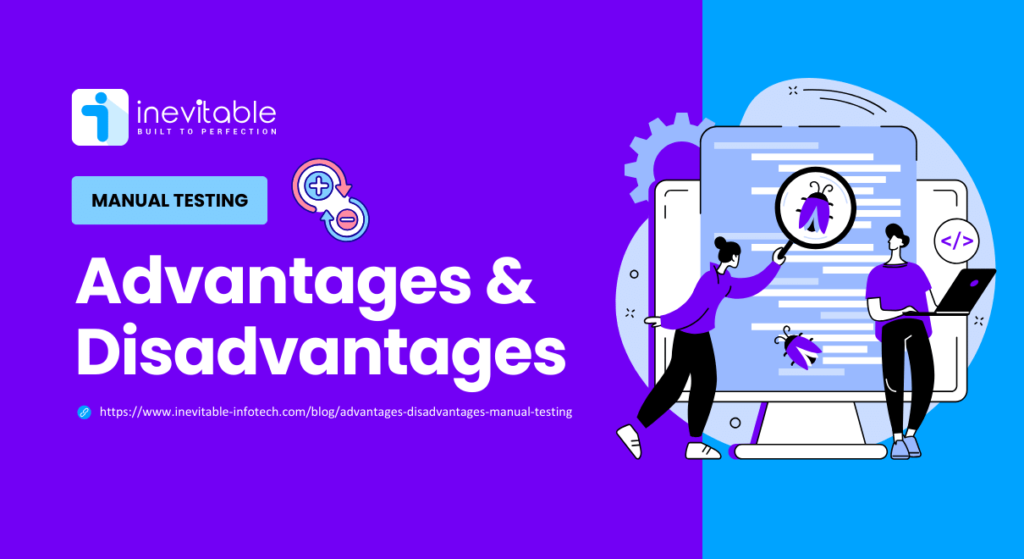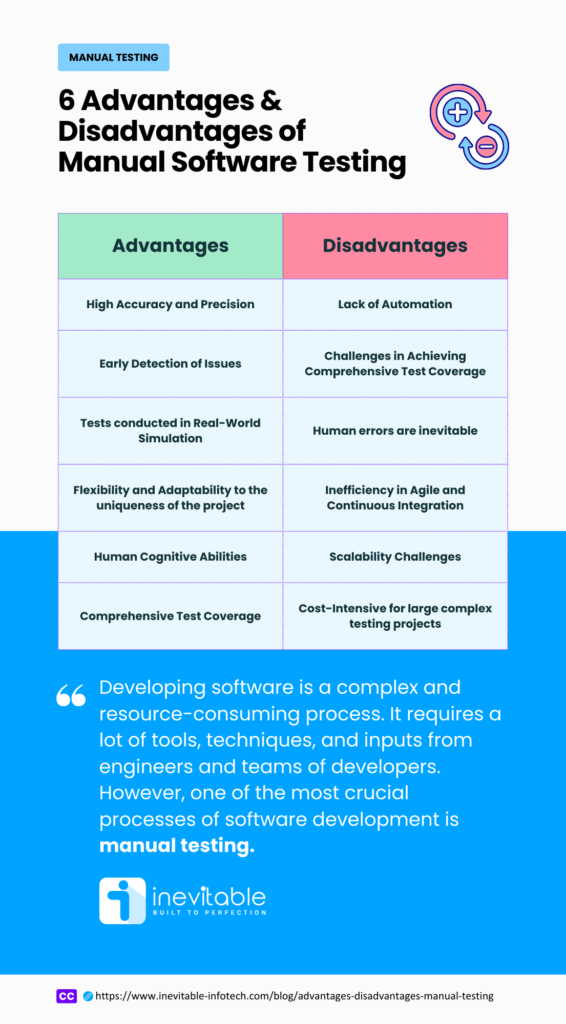
Manual Software Testing is a process that involves a human evaluator manually scrutinizing software to find bugs, defects, glitches, or potential issues. It is also done to validate the features and functioning of software before its release to ensure the best end-user experience. There are numerous advantages and disadvantages of manual testing; moreover, it must be included in the software development cycle.
Developing software is a complex and resource-consuming process. It requires a lot of tools, techniques, and inputs from engineers and teams of developers. However, one of the most crucial processes of software development is manual testing.
Manual testing facilitates the detection of nuanced issues of software that automated testing may not provide coverage for. In addition, human testers bring along human perspectives and interpretations that allow the exploration of unique use-case scenarios testing the limitations of the software functionality. Not only detecting bugs and limitations, but the advantages of manual testing also extend to validating whether the software is user-friendly, smooth, robust, and secure or not.
Despite being one of the crucial parts, manual software testing has its own set of pros & cons. Here is a list of all the advantages and disadvantages of manual software testing:
| Advantages of Manual Testing | Disadvantages of Manual Testing |
|---|---|
| High Accuracy and Precision | Lack of Automation |
| Early Detection of Issues | Challenges in Achieving Comprehensive Test Coverage |
| Tests conducted in Real-World Simulation | Human errors are inevitable |
| Flexibility and Adaptability to the uniqueness of the project | Inefficiency in Agile and Continuous Integration |
| Human Cognitive Abilities | Scalability Challenges |
| Comprehensive Test Coverage | Cost-Intensive for large complex testing projects |

What are the Advantages of Manual Software Testing?

Manual testing benefits the process of software development in different ways. These advantages of manual testing are listed below:
1. High Accuracy and Precision
A. Identifying Inconsistencies
Since the tests are done in real-world scenarios with human testers, the accuracy or precision of manual testing is further than automated testing. One of the benefits of manual testing over automation is that there is a low risk of false negatives.
False negatives refer to those reports that the DevOps team later needs to verify (whether the error is a genuine issue or not). Since a human tester already checks such reports in manual testing, it helps the DevOps team save a lot of time.
B. Verifying User Interface Elements
The benefits of manual testing also include the verification of user interface elements like buttons, color codes, checkboxes, resolutions, and more. Manual testing helps validate the UI functioning of software across platforms and operating systems.
Here, the advantage of manual testing over automation is that automated tools can never offer 100% pure human feedback, no matter how advanced it is.
C. Validating Complex Scenarios
The benefits of manual testing also extend to validating complex testing scenarios. Since human testers can quickly adapt to different requirements, dealing with a complex scenario is not a big deal. Without any additional technical support, coding, or heavy maintenance that automated tools require, manual testers can modify their test cases to deal with the complexity of software.
2. Early Detection of Issues
A. Identifying Bugs in the Early Stages
Manual testing advantages the process of software development by identifying loopholes from a very early stage. Human intervention in such a process is crucial as the software is tested from the most critical metric called the “User Experience.” With the project requirements and goals in mind, a manual tester can check the front-end & backend of the developing software to find errors and potential issues.
B. Reducing Development Costs for Small Projects
When a bug is detected in the initial phase of development, it gives the developers a chance to fix it then and there. Fixing such issues costs much less than fixing problems in the later stages of development. Manual testing can save a significant amount of money.
C. Enhancing Software Quality
Manual testing doesn’t just help in making the software development cycle more effective. Early detection of bugs also opens doors for innovative solutions to fix the bugs detected. With a highly skilled team of developers, the software can be upgraded and enhanced to offer the best end-user experience.
3. Tests conducted in Real-World Simulation
A. Mimicking User Interactions
In the manual testing vs automation testing debate, manual testing beats automation due to its ability to replicate real-life user interaction. Testing engineers follow predesigned test cases, scenarios, or backstories to perform certain tasks. It generates various user interactions within the software through data input and navigation of screens and helps verify whether the software is behaving according to expectations or not.
B. Ensuring User-Friendly Experiences
Another area of highlighting the advantages of manual testing over automation is that only manual testing can ensure whether the software is user-friendly or not. Automation tools can never offer authentic human feedback on how the software looks and feels, how the visual components work, or which UI and UX issues can be improved.
C. Exploring Edge Cases
Manual testing also provides coverage for exploring edge cases. Edge cases are those out-of-the-ordinary test cases or scenarios that are usually not likely to happen. But in case they happen, the software must know how to behave.
Manual testers help test software even under these extraordinary circumstances to ensure they are built robustly and efficiently.
4. Flexibility and Adaptability to the uniqueness of the project
A. Testing Unscripted Scenarios
A well-experienced and knowledgeable manual tester can provide certain benefits of manual testing. One such benefit is testing unscripted scenarios.
Based on their knowledge or previous experiences with other projects, testers can offer unscripted test scenarios to test bugs. This technique is often called the “Error Guessing” technique, which is unique to manual testing.
Automated tools cannot think, plan, or perform this way. Implementing such features in automated tools requires extra coding and maintenance of it. However, even that does not ensure the accuracy of its outcome.
B. Adapting to Evolving Requirements
Sometimes, a software development cycle consists of several changes in its requirements. It may start with a certain vision but may go through a few modifications before that vision is solidified into a project goal. For projects like that, manual testing is the best option to be implemented.
The reason is that manual test cases are easy to set up, restructure, and modify throughout the whole developmental process. Owing to its flexible nature, it is a better option than automated testing.
C. Handling Customized Testing
Other manual testing advantages include the customizability of manual tests according to the requirements of the software. Automated tools are designed to perform various functionality tests in a very short time. However, if the requirements differ, they may fail to provide the necessary coverage.
However, manual testers come up with new perspectives, innovative solutions, test scenarios, and structures that are customized to fulfill the needs of the project requirement.
5. Human Cognitive Abilities
A. Emulating Human Thought Processes
Manual testing offers various human cognitive benefits in the development of software. This is because human testers can step into the shoes of real-life users and replicate their behavior under certain circumstances.
Automated tools or testing can offer only a limited number of possibilities. Still, manual testing can capture the authentic user behavior and thought process that is required to make software error-free.
B. Evaluating Subjective Aspects
The benefits of manual testing can also be seen in terms of evaluating subjective aspects such as user experience (UX), user interface (UI), and the overall look or feel of the product. The coverage of automated testing also fails here as manual testers can offer feedback on emotional response, contextual understanding, localization, and cultural sensitivity of software.
C. Assessing User Experience
So, we can understand how manual testing is an efficient mode of testing the visual and interactive elements of a software application. It helps ensure that the software is visually pleasing, the interface is intuitive, and runs smoothly on various platforms and operating systems. This way, manual testers assess the end-user experience of developing software to spot areas of enhancements.
6. Comprehensive Test Coverage
A. Addressing All User Scenarios
One of the advantages of manual testing is that it can offer all user test case scenarios to make software robust and reliable. These tests include exploratory tests without any predetermined scenarios, user-perspective tests, contextual tests, edge tests, and more.
B. Ensuring Cross-Device Compatibility
Manual testing allows the software to be run and tested on various arrays of devices, platforms, and operating systems. Testers manually interact with the software on different screens, browsers, and devices with different hardware & software combinations to ensure the smooth operability of the software across devices and platforms.
C. Verifying Integration with Third-Party Systems
Another aspect of the software development cycle where manual testing is instrumental is the validation of software behavior in terms of third-party systems. Testers manually check the communication bridge, data exchange, compatibility, and functionality of the software. The purpose of this kind of assessment is to identify the presence of any discrepancy or security vulnerability.
What are the Disadvantages of Manual Software Testing?

Though we have been discussing the advantages of manual testing at length, there are also certain challenges in manual testing. Let’s have a look at all the cons of manual testing now:
1. Lack of Automation
A. Time-Consuming Test Execution
One of the major disadvantages of manual testing is that it can be considerably time-consuming. It is a very methodical, detailed, and primitive approach that can extend long duration of testing cycles. Hence, manual testers need to find the right balance between thoroughness and timelines to ensure there is no extension of deadlines.
B. Repetitive Tasks
Manual testing also can be repetitive and boring. Validating the software functionality across the developmental cycle can be a prolonged task that demands consistent focus, attention to detail, and a lot of concentration. As a result, testers may suffer from fatigue which may lead to compromising the quality of the test or rising inaccuracies.
C. Resource-Intensive
The other drawback of manual testing is that it requires a lot of workforce and financial investment. Human resources refers to highly skilled individuals who know how to identify bugs, perform tests, create test cases, and comprehensively document the whole process. Financial investment is required in hiring another team of developers who can collaborate with the testers effortlessly. For smaller projects, manual testing can still be cost-efficient but for large and complex projects it can cost a fortune.
2. Challenges in Achieving Comprehensive Test Coverage
A. Subjective Nature
Though manual testing brings forth human perspectives, it may sometimes lead to inaccuracies due to the lack of objectivity. Human testers may let go of certain issues unidentified, leading to major functional defects in the software application. It is very important therefore to ensure standardized tests to avoid such risks of manual testing.
B. Difficulty in Handling Complex Scenarios
This factor counts as both the advantages and disadvantages of manual testing. The act of manually testing each possible scenario becomes a daunting task in the case of a complex project. It is also difficult to always grasp the complexity of a project and ensure all the pathways are tested and accurately validated. So, under such circumstances, automation testing can reduce the load of the tester’s responsibilities.
C. Risk of Missing Critical Areas
Other disadvantages of manual testing include the failure to conduct extensive tests to safeguard against functional discrepancies, performance issues, security breaches, and other vulnerabilities. Oversighting critical areas during manual testing can lead to significant financial, reputational, and operational damages to the software.
3. Human Error
A. Inconsistent Test Execution
Since manual testing is wholly dependent on human intelligence and behavior, it is also very prone to human-made errors. Oversights, misinterpretation, variations, inconsistencies, all these factors play a major risk factor in the process of manual testing. It is because of this reason that testers are usually recommended to test their software with automation after manual testing is performed.
B. Fatigue and Burnout
Unlike machines, human beings can run out of energy and suffer from a loss of competency when they get tired. Since manual testing is a laborious process of long test cycles, any kind of fatigue or burnout can reduce the efficiency of a manual tester leading to inaccurate readings.
C. Risk of Oversight
Another risk factor that remains in manual testing is the risk of oversight. Irrespective of the expertise, manual testers are prone to oversights especially when they are dealing with repetitive tasks. Such errors can lead to operational failures, and security breaches and affect customer satisfaction.
4. Inefficiency in Agile and Continuous Integration
A. Slows Down Rapid Development
In agile development of software applications, frequent changes, quick test cycles, and rapid iterations, all these factors are required. However, whenever manual testing is introduced in the agile development cycle, it may hinder the whole process creating bottlenecks in the pipeline. The slow process of bug detection and software validation then furthermore delays the process of integrating new features and updates.
B. Bottleneck in CI/CD Pipelines
CI/CD pipelines offer seamless, smooth, and automatic integration and delivery of code changes. It is done to accelerate developmental cycles while improving the quality of the software. However, the incorporation of manual testing into these pipelines will require constant human intervention. Thereby slowing down the regular updates, features, and fixes and reducing the effectiveness of the CI/CD approach.
C. Impacts Agile Flexibility
The disadvantages of manual testing in the agile development cycle are numerous. To begin with, it slows down the entire process owing to its time & resource-intensive nature. Secondly, consistency becomes a matter of difficulty due to human variability. And lastly, it requires a certain level of flow and responsiveness to maintain agile flexibility, which is constantly disrupted by human interventions.
5. Scalability Challenges
A. Difficulty in Managing Large-Scale Projects
Manual testing has its own set of challenges when it comes to managing large-scale projects. This is mainly due to its increased demand for highly skilled human resources and time. Hence, scaling manual testing for large projects, without human resources, can lead to bottlenecks, inconsistencies, and failure to deadlines.
B. Resource Constraints
The unavailability of skilled testers can pose major disadvantages in the manual testing of software. It may eventually also lead to extended costs, failure to meet deadlines, and potential compromises in the quality of the software.
C. Impact on Growth
Owing to the lack of scalability a company’s growth can also be affected indirectly as one of the disadvantages of manual testing. Lack of skilled manual testers will affect the company’s ability to adapt to increased demands or meet industry quality standards. This leads to serious reputational loss and in turn, hinders the growth of a software development company.
6. Cost-Intensive for large complex testing projects
A. Labor Costs
Though manual testing is very cost-effective for small and simple projects, it is equally expensive for large and complex ones. The cost of labor goes up depending on the expertise of the manual tester, the complexity of the project and the time it will take to complete the whole testing cycle. Considering it all, labor cost is another of the disadvantages posed by manual testing.
B. Training and Onboarding Expenses
For hiring a dynamic team of experts, company expenses usually go up as the company has to keep in mind that such a team of manual testers needs training materials, tools to learn QA analysis, methodologies, and more stuff.
C. High Maintenance Costs
Additionally, maintenance costs are also pretty high for manual testing. Maintaining and updating the testing environment, tools, and techniques all of these require a constant flow of finances. Plus, conducting regression testing for new and updated features costs more. Finally, the discovery of defects and the resources required to fix them extend budgets if not planned properly from the beginning.
Conclusion
We can conclude that there are both advantages and disadvantages of manual testing. Amongst the advantages we can highlight that manual testing offers comprehensive and detailed test cycles for intricate functionalities of a software application. It also offers a real-time assessment of the user experience, emotional response, thought process, and human perspective. It guarantees extensive test cases and scenarios that can provide full coverage to all user behavior and scenarios.
However, it is not a foolproof method that only has to offer great benefits. Some of the disadvantages of manual testing include its time-consuming process. The repetitiveness of the testing procedure can cause delays in agile development. It is prone to human errors and inconsistencies. And in this method, objectivity is highly compromised. Ideal for small and simple projects, manual testing can cause budget extension for large and complex models of software.
B. The Future of Manual Software Testing
Considering all the manual testing advantages and disadvantages, it won’t be inaccurate to say that the future of manual testing is poised for integration with automated testing. As human intuition, perspective, creativity, and all these aspects are irreplaceable, the rise of AI and ML tools can only help speed up the process of assessment in manual software testing. The right combination of both automation and manual testing can hold significant value for all the emerging technologies of the future.
Frequently Asked Questions (FAQs)
Can automation replace manual testing?
No, automation testing can never replace manual testing, entirely. While automation can help improve the efficiency of manual testing by detecting unidentified errors, or by reducing the time required for testing cycles, QA testing for software will always require human intuition, perspective, and intelligence to improve the quality of software.
What is the advantage of manual testing over automation testing?
The main advantage that manual testing has over automation is the ability to combine human insight and analytics in the making of next-generation software solutions. The whole relevance of manual testing lies in the ability to detect nuanced issues beforehand to solve them for a better user experience.
What industries benefit the most from manual software testing?
Several industries can benefit from manual software testing, such as
- Healthcare industry
- Gaming industry
- Education
- Finance
- E-commerce
When Should I Transition from Manual to Automated Testing?
The transformation from manual to automated testing can be done:
- During repetitive test cycles to speed up the procedure.
- While opting for CI/CD practices
- When the complexity of the software is high
- When the volume of test cases increases across developmental cycles




